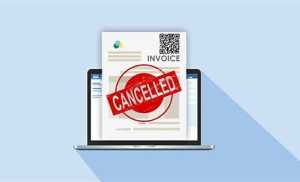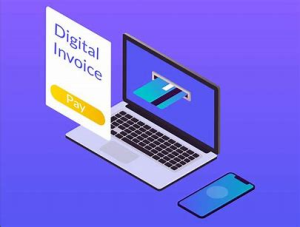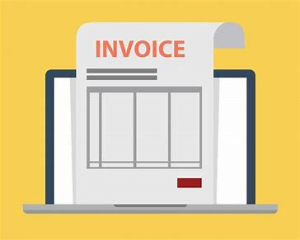E-invoicing aims to enhance transparency and reporting of B2B transactions under GST. However, invoice generation is a complex, multiparty process with the potential for errors or changes in deal terms requiring amendments.
To address this, the e-invoicing framework allows cancellation of invoices within a defined time period. But aspects like process, rules for cancellation, and documentation remain unclear for taxpayers.
This extensive guide details step-by-step procedures to cancel e-invoices, along with reconciliation requirements. It also provides clarity around key considerations to enable seamless adoption of cancellation capabilities, prevent penalties, and ensure systemic compliance.
E-invoice cancellation procedure

The e-invoice cancellation process involves:
-
Logging into the Invoice Registration Portal (IRP)
The first step in the cancellation procedure involves logging into the Invoice Registration Portal (IRP), where the invoice was originally reported and registered. IRPs like NIC or authorized third parties like Clear handle invoice registration requests and corresponding cancellation processing. Taxpayers should login using the authorized organizational credentials and registered user ID and password to access the IRP system. This takes them to the dashboard with various menu sections.
-
Locating the specific e-invoice
After logging in, taxpayers need to locate the details of the specific invoice they seek to cancel. This can be achieved by selecting the ‘Cancel e-invoice’ option and then entering either the 64-bit invoice reference number (IRN) that was originally generated or the 49-bit acknowledgement reference number provided at generation time. Using these unique keys, taxpayers can retrieve and display the registered invoice targeted for cancellation.
-
Selecting an appropriate cancellation reason
IRPs provide standard, predefined cancellation reasons to choose from when submitting requests. Some common options include purchase order cancellation, data entry errors, duplicate invoice generation, etc. Taxpayers should select the reason closest to the actual trigger warranting cancellation of the invoice for correct reporting.
-
Adding cancellation remarks
In addition to selecting a cancellation reason, taxpayers can enter free text remarks detailing key specifics around the reason cited or events necessitating cancellation. These remarks aid in maintaining essential cancellation audit trails for future taxation proceedings, if needed.
-
Final submission
After entering accurate invoice details, choosing the cancellation reason, and detailing supporting remarks, taxpayers have to finally submit the cancellation request on the IRP. After this final submission, IRPs start processing by marking the invoice as officially cancelled within their system and enabling status updates across linked government systems.
-
Updating other systems
Once IRP marks the processed invoice as cancelled, corresponding updates need to be made by taxpayers in their connected financial accounting, billing systems, or GST returns to record the invoice cancellation. This includes aspects like creating linked credit or debit notes, modifying return documents, etc.
-
Documentation
Printing and preserving the cancelled invoice copy, displaying the “cancelled” stamp, credit or debit notes raised, and updated returns is vital to completely closing the audit trail for future taxation assessments or audits if needed.
Thus, end-to-end management requires disciplined steps across systems to fully reverse an issued e-invoice.
Also Read: Best Practices for E-invoice Cancellation: Ensuring Accuracy and Compliance
Steps to cancel an e-invoice
Detailed aspects across the standard e-invoice cancellation steps:
Step 1: Login to the IRP Portal
- Relevant IRPs are the NIC portal or GSPs like Clear, where the invoice was originally reported.
- Use the organization’s registered ID and password credentials.
- The IRP dashboard opens with menu sections.
Step 2: Locate the e-invoice.
- From the menu, choose e-invoice and select the “Cancel” option.
- Enter either an IRN or the original acknowledgement. Reference to the invoice requiring cancellation
- Click “Go” to retrieve invoice details.
Step 3: Select the cancellation reason.
-
Select the right cause from the drop-down menu:
- Order cancelled
- Duplicate invoice
- Data entry mistake
- Other errors
-
Add free text remarks detailing cancellation triggers.
- Buyer P.O. cancellation number
- The correct invoice number
- Accounting errors
- GSTIN corrections, etc.
-
Include contact details for future clarifications.
Step 4: Submit the cancellation request.
- Verify all the information entered accurately.
- No changes are permitted post-submission.
- Click “Submit” to initiate the cancellation process.
Step 5: Save the cancelled invoice copy.
- The system displays a cancelled invoice with a “cancelled” stamp.
- Save a soft or hard copy for records.
- Attached are credit or debit notes raised later.
Step 6: Create a corresponding credit or debit note.
- Raise a credit or debit note to nullify the cancelled invoice’s financial impact.
- Enable linkage tagging for cancelled IRNs where possible.
- Helps with money settlement with the buyer
Step 7: Update GST Return
- Auto-populated B2B invoice tables in GSTR-1 mark cancelled status
- Ensure there is no tax liability leakage arising from such invoices.
- Reconcile values as part of return filing activities.
Therefore, standardized operational steps coupled with downstream updates across systems ensure clean process closure.
E-invoice cancellation guide

A comprehensive guide detailing cancellation processes, rules, documents, etc. greatly aids compliance. Key elements to cover:
Cancellation Scenario Summary
Table: Common Business Scenarios Warranting E-Invoice Cancellation
| Scenario | Example | Cancellation Reason | Remarks Suggestion |
| Order cancellation | Good discontinued, fresh P.O. received | Order cancelled | New PO number and item details |
| Erroneous details | Wrong shipping address and payment terms | Data entry mistake | Correct address and terms |
| Duplicate invoices | System lag caused repeat IRNs | Duplicate invoice | Actual invoice number |
| GSTIN error | The test invoice was reported with the wrong GSTIN | Other error | Buyer’s correct GSTIN |
Such illustrative scenarios make the selection of cancellation reasons and remarks relevant.
Time Limit for Cancellation
One of the foremost rules to be included in the cancellation guide is highlighting the process time limit. Taxpayers must note that e-invoice cancellation requests can only be submitted on IRP within 24 hours from the time the original invoice was registered and the IRN was generated. Beyond this 24-hour mark, taxpayers will not be allowed to cancel invoices on the IRP; rather, corresponding credit or debit notes will need to be created with relevant declarations made manually during GST return filing, like GSTR-1.
Key Cancellation Rules
- Partial cancellation is not allowed; the full invoice needs reversal.
- Cancelled IRNs cannot be reused or amended later.
- Active e-waybill linkage blocks cancellation approval.
- GSTR-1 auto-updates only when cancelled within 24 hours; otherwise, manual inputs are needed.
Thus, creating awareness of varied operational aspects through an internal cancellation guide proves beneficial for staff.
Want to know about the recent updates in ITC rules and regulations for e-invoices? Then you really need to check out this blog post by Captainbiz.
Also Read: Challenges and Solutions in E-invoice Cancellation Process
Cancelling an issued e-invoice
Common reasons warranting cancellation include:
-
Purchase order cancellations
Under common business scenarios for issued invoice cancellations, purchase order cancellations rank among the foremost situations. These could arise when the client organization initiates cancellation of ordered products or services before actual delivery or performance obligations are met.
Sudden closure of buyer facilities due to externalities like lockdowns or natural disasters also leads to the falling through of issued invoices. Broader instances like client budget constraints, organizational restructuring, etc. also lead to a reduction in initial purchase values, triggering the need for corresponding invoice cancellations.
-
Erroneous invoice details
Another regular trigger for invoice cancellation occurs when inaccuracies or incorrect mentions are noted post-generation. Mismatches or errors found in key details like shipping location pincodes, product codes, account information, etc. require a reversal of the invoice.
Units’ quantity reaches and classification errors in applicable tax rates also call for cancellation bites. Such data inaccuracies, if not addressed, can severely impact fulfillment and payment settlement.
-
Duplicate Invoices
Certain exceptional situations, like recurring failures with internet connectivity, drop-in API responses, etc., within invoice reporting systems end up creating duplicate invoices carrying the same date, value, and product-customer information.
Similarly, test transactions occasionally get tagged as live invoices, feeding wrong information into the ecosystem. Detection of duplicate IRNs due to such systemic failures warrants cancellations, which help sustain data sanctity.
-
Post-Generation Corrections
Specific business circumstances also make amendments to issued invoices due to enhancements in product bundles or service levels based on renegotiation with buyers. Changes in pre-agreed delivery periods and payment cycles also map the need to revise invoice values or timelines. Sudden pricing revisions arising due to market fluctuations or regulatory policies also create the need for cancellation and reissuance.
Clearly, a range of factors—human errors, technical glitches, evolving business needs, etc.—need invoice cancellation capability.
Process for revoking an e-invoice
The standard process flow to revoke an issued e-invoice spans:
-
Change Intimation
The first segment in the e-invoice revocation process commences with the receipt of a request for change, whether directly from the buyer via a purchase order amendment or identified by the supplier’s own internal evaluation teams. Businesses may receive requests to alter product bundles, delivery addresses, payment terms, etc., making previous invoices invalid.
-
Cancel the invoice on IRP
On receiving a firm change request that makes an existing invoice legally void, suppliers then submit details of the corresponding invoice marked for cancellation on the GST IRP, as elaborated in earlier sections. Reasons cited or errors made are detailed in the respective remarks to revoke the invoice.
-
Communicate with the Buyer
Post-submission on IRP, the supplier formally communicates confirmation to corresponding buyers on cancellation request submission for the particular invoice on the concerned date. Expected timelines for the issuance of revised and corrected invoices are also mostly detailed.
-
Process Finalization
To sustain the audit trail around cancellation, suppliers generate linked credit or debit notes mapped to the cancelled invoice. Return filing forms are also updated to prevent inflated tax liabilities. Printed invoice copies were destroyed post-portal acknowledgement of cancellation.
-
Reissue the corrected invoice
If a business transaction continues to remain valid in principle, barring amendments, a regenerated invoice will be issued to the buyer with accurate details as needed. A new IRN is generated, and an old cancelled one is permanently discarded.
Clearly, a number of downstream activities across departments get triggered for comprehensive management.
Reversing e-invoice issuance

Key measures to reverse issuance and complete the process closure include:
Destroying Cancelled Invoice Copies
To certify permanent reversal, businesses should physically destroy printed invoice copies that bear a cancelled IRN, following due internal authorization protocols. This sustains compliance by preventing potential misuse, duplication, or representation risk.
Freezing Cancelled IRN Permanently
Equally crucial is freezing the specific IRN cancelled within billing and accounting systems through appropriate audit controls. This avoids accidental or fraudulent attempts to regenerate invoices with the same deemed invalid IRN due to its dormant status.
Documenting the Cancel Event Audit Trail
Every event around invoice cancellation, starting from change requests to approval, submission to the IRP along with credit and debit notes, fresh invoices raised, and GST return extracts reflecting cancellation, should be chronologically logged in a statement for future reference. A complete date-wise sequence helps invalidate claims.
Such aspects help sustain process integrity and transparency for future audit or tax proceedings.
Conclusion
E-invoice cancellation helps correct errors and changes in invoice generation systemically. Taxpayers canceling B2B invoices should adhere to defined IRP protocols, applicable rules, and downstream updates. Seamless data flow across billing, supply chain, and tax return systems post-cancellation also aids compliance.
With increasing e-invoice adoption among MSMEs, such cancellation measures bring ease, flexibility, and facilitation without needing manual interventions or prolonged business disruption. Adopting a comprehensive cancellation guide, responsible usage, and integrated GST tools assures a frictionless, trusted e-invoicing environment.
Also Read: Reconciliation Of Canceled E-Invoices
FAQs
-
When is cancellation of an e-invoice not permitted on the IRP?
Cancellation is not allowed if an e-way bill has been generated and is live for the particular invoice. Rectification is only possible through credit or debit notes later.
-
Can a cancelled IRN be reused to generate another e-invoice?
No, a cancelled IRN cannot be utilized again or amended for subsequent invoice registration by IRP. A fresh IRN generation is needed.
-
How do I cancel an invoice raised by the wrong GSTIN buyer?
Submit a cancellation request on IRP with the reason “Other Error.” Remarks should capture the correct buyer’s GSTIN. Then issue a credit note to the original GSTIN and a fresh invoice to the accurate buyer.
-
What happens if the e-invoice cancellation timeframe of 24 hours elapses?
After 24 hours, taxpayers have to manually cancel or update details in their GSTR-1 return for corresponding B2B invoices. IRP level changes are not possible.
-
When are credit or debit notes mandatory to cancel an e-invoice?
If 24 hours have lapsed since IRN generation, corresponding credit or debit notes will become mandatory to nullify financial impact and enable accurate ITC claims across parties.
